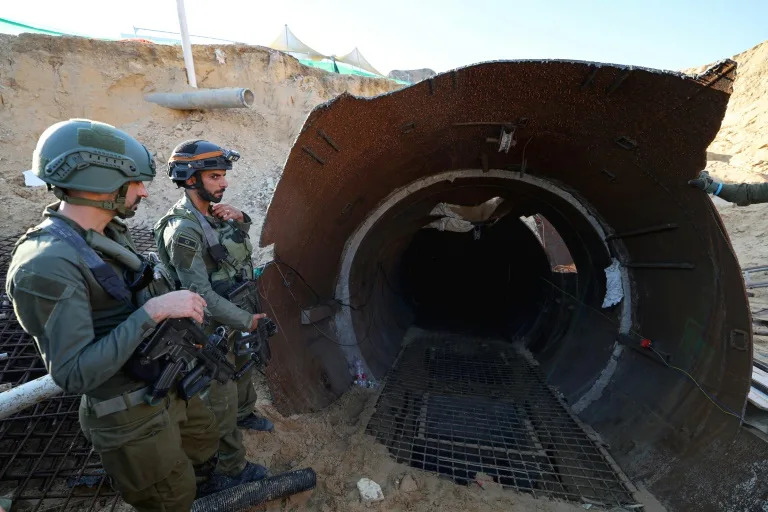The Israeli army said on Sunday it had uncovered the biggest Hamas tunnel in the Gaza Strip so far, just a few hundred metres from a key border crossing.
Such was its size that small vehicles would be able to travel within the tunnel, an AFP photographer granted access to it reported.
The tunnel reached within 400 metres of the Erez crossing with Israel
The underground passage formed part of a wider branching network that stretched for over four kilometres (2.5 miles) and came within 400 metres (1,300 feet) of the Erez border crossing, the army said in a statement.
It cost millions of dollars and took years to construct, Israeli forces said, with the project lead by Mohamed Yahya, brother of Hamas chief Yahya Sinwar, who is believed to have masterminded the October 7 attacks.
The honeycomb of passageways features a drainage systems, electricity, ventilation, sewage and a communication network as well as rails.
The floor is compacted earth while its walls are reinforced concrete and its entrance is a metal cylinder with 1.5 centimetre (half-inch) thick walls.
Footage released by the Israeli army, which it said was filmed by Hamas, showed a small construction vehicle being driven into the tunnel, an extensive temporary warehouse filled with pre-cast concrete for lining the walls and workers digging beneath the earth using crude power tools.
The Israeli army said it had found a large number of weapons stored in the tunnel, ready to be used in an attack.
- People, goods, weapons -
Hamas had expended huge resources in the project, said Lieutenant Colonel Richard Hecht, an army spokesman, and did so to "serve only one purpose -- attacking the State of Israel and its residents".
He said the tunnel was deliberately built near the Erez crossing, which Israel uses to facilitate the strictly controlled entry of Palestinian workers and those travelling for medical care.
"For Hamas, attacking the people of Israel continues to take priority over supporting the people of Gaza," he said.
The Islamist militant group launched a surprise attack against southern Israel on October 7, killing around 1,140 people, mostly civilians, and taking about 250 hostages, according to the latest Israeli figures.
In response, Israel set out to destroy Hamas and launched a relentless bombardment and ground invasion of the Gaza Strip to achieve that goal.
The Hamas-run health ministry in Gaza says Israel has killed more than 18,800 people, mostly women and children, during the war.
Dubbed the "Gaza Metro" by the Israeli military, the labyrinth of tunnels beneath the coastal territory was initially devised as a way of circumventing the crushing Israeli-Egyptian blockade, in place since 2007.
Hundreds of tunnels were built under the border with Egypt and into the Sinai Desert, allowing people, goods and weapons to cross into Gaza from the outside world.
Since the 2014 war with Israel, the tunnel network has been expanded and Hamas has made frequent use of it to facilitate its rocket launches.
A study published on October 17 by the Modern War Institute at the US military academy West Point said there were 1,300 tunnels stretching over 500 kilometres (310 miles).
The Israeli army said at the beginning of December that it had discovered more than 800 tunnels, with 500 destroyed.
Reports in Israeli media last week said that the army was considering flooding the tunnels with seawater pumped from the Mediterranean and had already conducted succesful tests.
Inside the Hamas tunnel network
What strikes you first about the tunnel is its size. Jutting out from the desert sand at a gradient of about 25 degrees, the rusty tubular steel opening is just big enough to drive a car through.
That is far from an accident. Hamas, as it proved on Oct 7, is a mobile terror group and this vast tunnel network, running 50m deep in places and emerging just shy of the Erez Crossing at Gaza’s northern tip, is believed to have been designed for a wider invasion of Israel.
“From here you can be in Tel Aviv in 50 minutes and Jerusalem in an hour,” says one of the soldiers charged with taking us into it.
The Erez tunnel network is about four kilometres in length – the biggest discovered since the war started, according to the Israel Defense Forces (IDF).
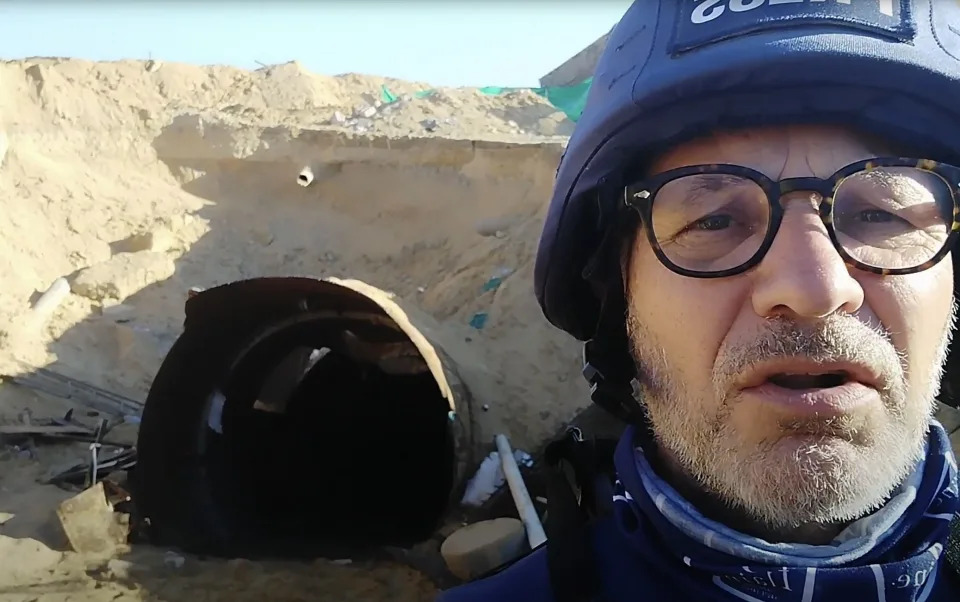
Its construction appears to have been personally overseen by Mohammed Sinwar, the younger brother of Yahya Sinwar, Hamas’s leader in Gaza and the brains behind the Oct 7 massacre in which more than 1,200 victims died.
Before being escorted into what an IDF spokesman dubs “the subterranean tunnel system that the Sinwar family had hoped to keep secret”, we’re shown a Hamas video, said to have been retrieved from Gaza. It documents the building of the labyrinth and includes a clip of Sinwar junior being driven around it in a small 4x4.
By then his brother Yahya had been released from an Israeli jail where he spent 22 years for a series of gruesome murders committed in Gaza in the 1980s. In prison he boasted of having made a man bury his own brother alive, handing him a spoon to finish the job.
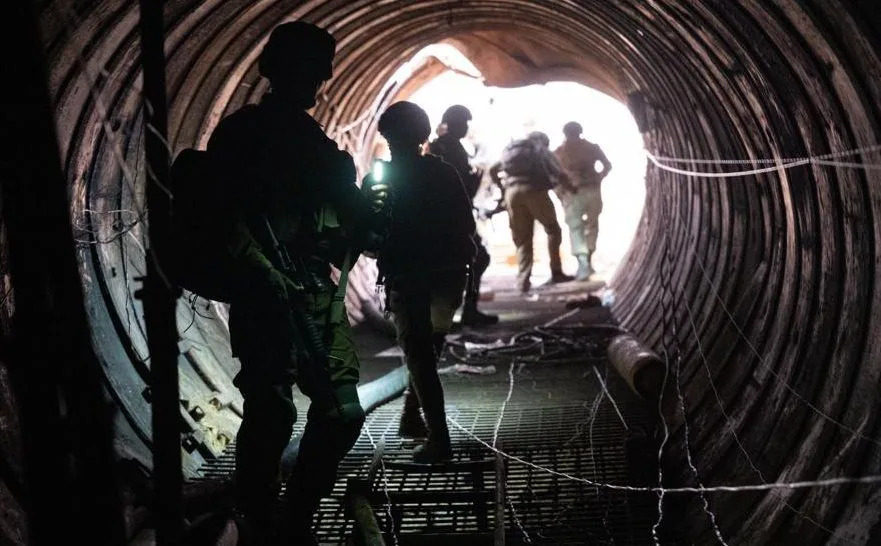
“A Hamas activist in every fibre of his body. A figure of a leader with the personality of a murderer,” noted Micha Kobi who interrogated him at the time for Shin Bet, Israel’s internal security service.
“Religiously extreme, a believer, one who is at peace with his words and his deeds… a psychopath”.
At the entrance to the tunnel, we step over two, metre-square shafts that plummet vertically down. Steel ladders are pinned to the wall of each but you can’t see the bottom, giving a slight sense of vertigo as you enter.
A soldier to my right says he thinks the shafts were designed to collect sand that would otherwise fall inwards and block the main passage when the tunnel’s entrance was opened from within as part of a surprise attack. “We see the same in other attack tunnels,” he says.
He and his colleagues will destroy them with explosives along with the rest of the tunnel network once we’ve left.
For the first 10 or 15 metres, the walls are clad in the same steel sheet that is visible from the surface. It’s pitted and coloured with a deep rust, moisture from the thick air condensing against it. Further in, the sheeting gives way to hefty circular steel ribs before the walls straighten and the modular concrete arches seen in most other parts of the Gaza Metro take over.
Along the walls on either side, cables are slung for communications, lighting and power just like in the London Underground. Deeper down, from about the point at which it starts to become harder to breathe, a plastic drainage pipe runs along the ceiling to provide ventilation.
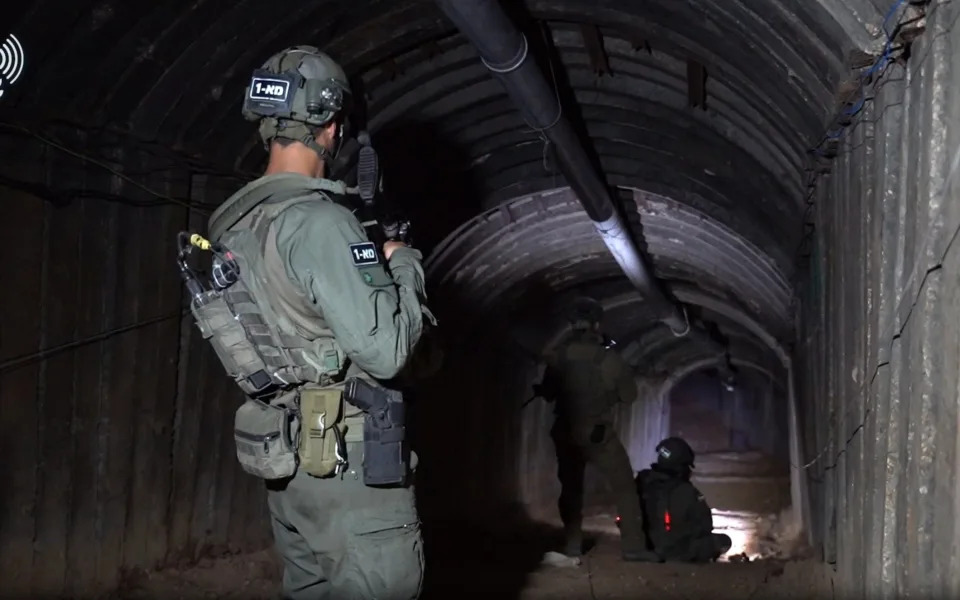
As we move further underground, temperature and humidity rise quickly, and you can see why Hamas is desperate for fuel to power its oxygen generators and ventilation pumps.
Even just 50 or 60 metres in and perhaps 10 metres beneath the surface, the air is dank and sickly. Your heart rate picks up, not with physical excursion, but with the metabolic effect of your body sweating to try to cool itself in a super-humid environment.
The idea of running, let alone fighting down here seems impossible and you can see why IDF troops only enter as a last resort. The frame of anyone moving in from the light becomes a perfect silhouette. A single combatant with a rifle could hold off a commando unit for hours.
We don’t see them, but further in there are subsidiary tunnels running left and right, says the IDF. Off these there are various rooms for storage, command and control and accommodation. Many of the entrances are protected by hefty steel blast doors.
“This tunnel is connected to a wider total network that we have discovered in other areas”, says an IDF spokesman. “We found a large number of weapons inside the tunnel in depots ready to be used. It’s all around the tunnel.”
The IDF believes the advance depositing of weapons in concealed areas above and below ground is one way in which Hamas managed to conceal its intentions ahead of Oct 7. “This is how they kept it a secret.” Fighters did not need to know in advance because the weapons depots were ready, said the spokesman.
While the main part of the tunnel was not used in the Oct 7 attack and is thought to have been kept secret for a separate assault, the IDF says other parts of the network were used to both stage the attack and retreat back into Gaza with hostages.
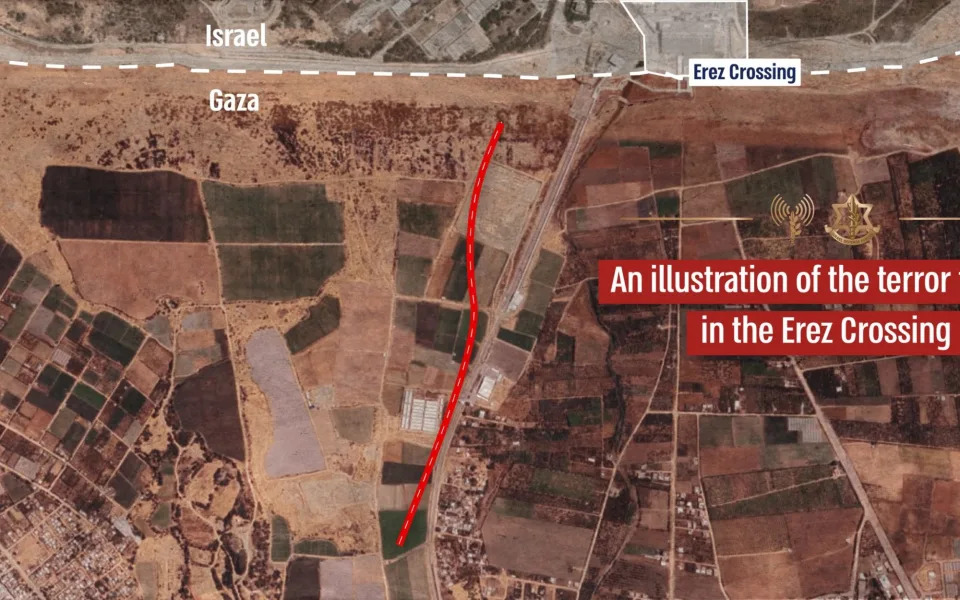
Walking through a spider’s web of tunnels
After her release at the end of October, 85-year-old Yocheved Lifshitz recounted being taken by her captors into a network of tunnels. “We went underground and walked for kilometres in wet tunnels, for two or three hours, in a spider’s web of tunnels,” she told journalists.
“We went through the tunnels until we reached a large hall. We were 25 people, and they separated us according to which kibbutz we were from.”
Other released hostages have described being held in rooms with little light or food. “Every day [in] there is like hell,” said 21-year-old Maya Regev. “Abnormal fear, zero sleep. At night the longings are crazy.”
The thud of heavy munitions hitting Gaza City could be heard in the distance when we were underground. The idea of that happening directly overhead while being held in anything like the Erez tunnel for months is the stuff of nightmares.
“Every day in captivity was extremely challenging. We were in tunnels, terrified that it would not be Hamas, but Israel, that would kill us, and then they would say Hamas killed you,” one freed hostage told Israel’s prime minister Benjamin Netanyahu in an angry meeting with the hostage families two weeks ago..
Aviv Havron, an Israeli newspaper editor, recounted how 10 members of one family were directly impacted on Oct 7. Three were murdered; six were kidnapped and later freed; and one, Tal Shoham, 38, continues to be held captive by Hamas in Gaza.
“It doesn’t matter if the hostages are on the ground or underground in the tunnels,” he replied. “Their lives are at risk every minute, and they must return home alive asap. Only later must these tunnels be destroyed.”
He’s right of course – the tunnels hold a gruesome fascination but it is the war itself that’s killing them.
Three hostages who escaped after a full 70 days in captivity were shot and killed by IDF troops just a few miles from us on Friday in the Shejaiya district of Gaza City. Despite being unarmed and holding a white flag, they were gunned down by an IDF soldier perched high in a nearby building.
As protests sprung up across Israel on Saturday, IDF Chief of Staff Herzl Halevi had to remind his troops – Israeli troops – that “it is forbidden to shoot at those who raise a white flag and ask to surrender”.
As we walked from the Erez tunnel on Friday, drenched in sweat and glad to be back in the sun, soldiers were preparing to mine it.
The blast will likely be filmed and cheered when shown to the public.
The IDF has promised to pursue Sinwar, who they say is “deep underground” in the Gaza tunnel network, until he is killed.
The concern for Israel’s policy-makers should be that, in their desire to extract vengeance on Sinwar for Oct 7, their trigger-happy excesses only play into his hands.
Israel is testing out flooding the Hamas tunnels. Here’s what it could look like scaled up
Seven weeks into Israel’s ground operation in Gaza, one of the key challenges facing the Israeli military is the labyrinth of Hamas tunnels that it says spans the entirety of the Strip.
In an effort to destroy the underground network, Israel has begun flooding some of Gaza’s tunnels with seawater, a US official told CNN on Tuesday, adding that the Israelis are “carefully testing out” the method “on a limited basis.”
If successful, flooding could be ramped up to degrade the tunnel network on a larger scale.
The method, however, is difficult and controversial. Even if implemented with sufficient amounts of water at high enough pressure, it may prove only partially successful. It also risks contaminating freshwater supplies and damaging whatever infrastructure remains on the surface.
For the Israeli government, it also risks killing hostages still held by Hamas in Gaza, many of whom are believed to be underground.
The Israelis are unsure whether the method will work, the American official said, but they assured the US that they are being careful to only test it in tunnels where they do not believe hostages are being held.
CNN has reached out to the Israeli military for comment.
A spokesperson for Hamas on Thursday said the group had built its tunnels to withstand possible attempts to pump water into them.
“The tunnels were built by well-trained and educated engineers who considered all possible attacks from the occupation, including pumping water,” Hamas spokesperson Osama Hamdan told a news conference in the Lebanese capital Beirut.
The tunnels however have also acted as an economic lifeline for Gaza’s residents, transporting people, goods and sometimes even American fast food amid a 17-year blockade imposed by Israel and Egypt.
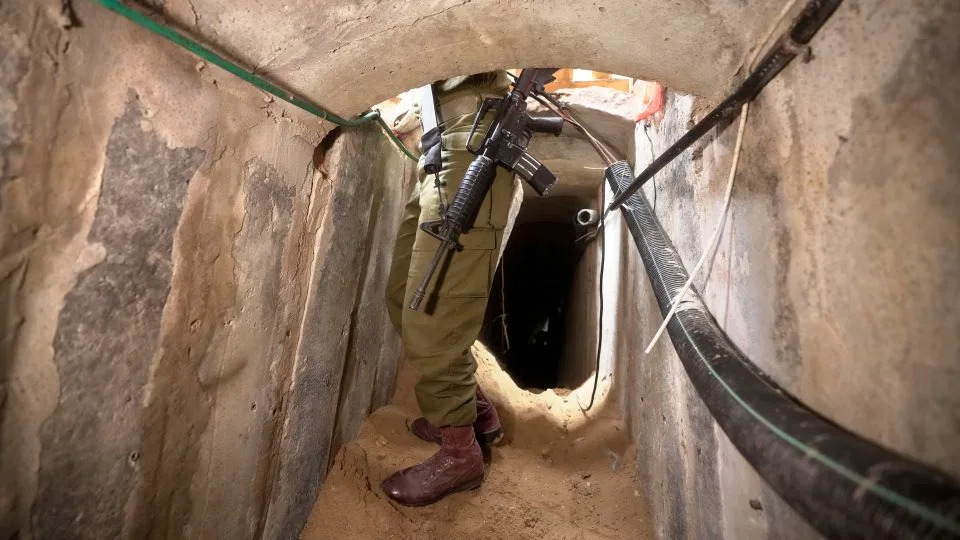
A tool of warfare
Tunnels have historically been used as a tool of warfare. They were used by the French in the interwar period, by al Qaeda in the mountains of Afghanistan and by the Viet Cong in the jungles of Southeast Asia.
Hamas’ tunnels are unique, however. They are “very innovative in their depth, in their sophistication, in their mining, in their trapping,” said Danny Orbach, a military historian at the Hebrew University of Jerusalem.
The subterranean structure is allegedly built under most of the Gaza Strip – a densely populated territory that is home to more than 2 million people – and by some accounts reaches a couple of hundred feet underground.
Hamas’ tunnels can be large enough to fit adult fighters, weaponry, goods and even cars, according to experts and footage released by the group. Some are reinforced with thick cement walls or are separated by metal doors, and not all of them are connected, experts say.
The scale of the Israeli military’s tests is unclear: how much water and how much pressure it is using to flood the tunnels it or even which tunnels it is targeting.
For the operation to succeed, the pressure with which the water is pumped into the tunnels would have to be high enough to destroy not only the cement walls, but also the thick, metal doors separating some of them.
At the very least, Orbach says, the flooding operation could force Hamas militants to move within the tunnels, which would aid Israeli intelligence in identifying militants and possibly hostages.
There will likely be complications
The method of shutting down tunnels by flooding them isn’t new for Israel or Gaza.
In an effort to shut some of the tunnels allegedly built by Hezbollah on the Israel-Lebanon border, the IDF in 2018 flooded them with cement, which ended up spilling out onto the surface in the southern Lebanese village above the structure.
Similarly, Egypt in 2013 began flooding tunnels running underneath its shared border with Gaza, using seawater, sewage water and cement to halt what it said was the smuggling of weapons by Islamist insurgents from the Strip into its Sinai Peninsula.
The water that flooded the tunnels rose to the surface, destroying crops, contaminating fresh water supplies and risking the spread of disease, Palestinian factions in Gaza later said.
In 2021, Hamas claimed to have built 500 kilometers (311 miles) of tunnels under Gaza. To put that in perspective, the Gaza Strip is just 41 kilometers long and up to 12 kilometers wide. CNN is unable to verify Hamas’ claims.
The Israeli military said this month that it destroyed at least 500 tunnel shafts in Gaza and located more than 800 around the Palestinian enclave. The IDF said last week that many of the tunnel shafts “were located in civilian areas” and inside civilian structures.
But the flooding process could have a devastating impact on the territory, depending on how it’s done.
Flooding tunnels underneath populated areas risks damaging the infrastructure that remains intact in the territory. It also risks contaminating the source of its freshwater, experts said.
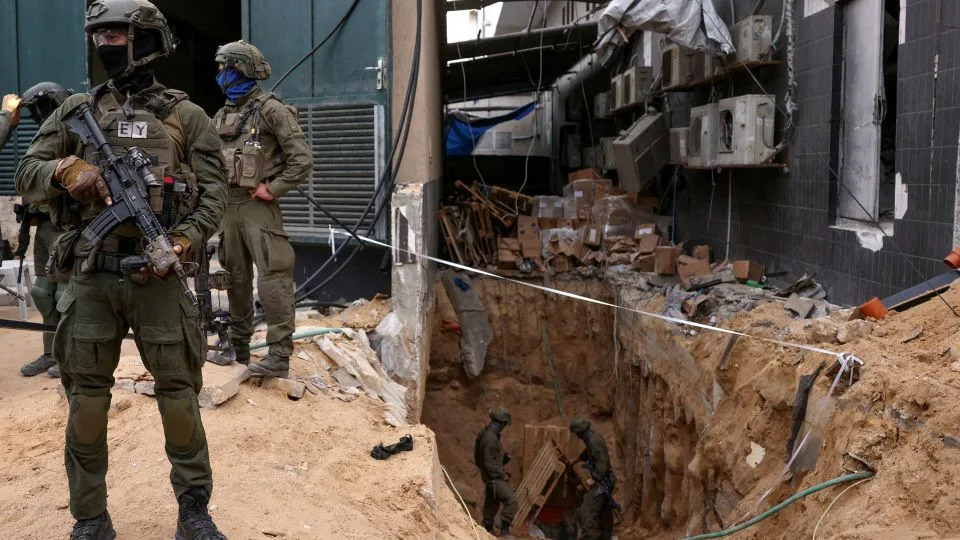
“I see one problem with seawater (flooding) for example,” Orbach said. “Gaza is a very sandy topography. That means that seawater can leak down and destroy the aquifers, the drinking water.”
The territory’s only freshwater resource, the Coastal Aquifer, is already being increasingly depleted by over-extraction and contaminated by sewage and seawater infiltration, according to Amnesty International.
The war has significantly curtailed access to drinking water, with aid agencies warning that Palestinians are being forced to drink dirty or salty water to quench their thirst, increasing risks of waterborne diseases.
If the entire network of tunnels is flooded, buildings on top of them could also collapse, Orbach said, adding that the damage could be extensive because so many of them are under civilian infrastructure.
The goal of the flooding, however, may not be to completely destroy the tunnels at this time, some experts said.
“Because the tunnels are so extensive and because so many of them are dug under infrastructure, buildings and schools and what not, there is a desire to incapacitate them in the moment, even if it doesn’t fully destroy them,” said Matthew Levitt, director of the Reinhard program on counterterrorism and intelligence at The Washington Institute for Near East Policy. The Israelis could work with a post-war governing body in Gaza about completely dismantling the tunnel network, he added.
“I imagine there is a consideration of how much seawater is necessary to make a tunnel unusable, as opposed to putting people’s lives at risk,” Levitt said, referring to the hostages believed to still be underground in Gaza.
“I think people have a vision of flooding the tunnels as pumping so much water in that the entire tunnel is without oxygen and just filled with water,” he said, “and I imagine that is not the case.”
Hostages may be in the tunnels
The most pressing concern for most Israelis today is the dozens of hostages still in Gaza, with many believed to be held underground.
The Israeli government is under intense public pressure to retrieve the hostages alive.
Leaked audio recordings of a meeting between freed hostages and Prime Minister Benjamin Netanyahu this month revealed anger at the prospect of flooding the tunnels.
A freed female abductee whose husband remains in captivity is heard on one recording as saying: “And you are talking about washing the tunnels with sea water? You are shelling the route of tunnels in the exact area where they are,” referring to heavy bombardment above of the tunnels.
“You put politics above the return of the kidnapped,” the woman adds. Israel believes there are 132 hostages still in Gaza – of whom 112 are thought to be alive, while 20 are believed to be dead, the prime minister’s office told CNN Friday.
Some of the hostages released by Hamas in October spoke about the tunnel system, describing the structure as a spiderweb.
Adina Moshe, who was dragged from her safe room in Israel and taken to Gaza on October 7th, was forced into tunnels five stories underground, according to her nephew Eyal Nouri.
“The bottom line is that Hamas invested tremendous time and money in this infrastructure, which is not for the benefit of the people in the Gaza Strip,” Levitt said, adding that from Israel’s perspective, it remains one of the most important military-critical infrastructure targets. “So, by one means or another, one can certainly expect that Israelis are going to be looking to disable the Hamas tunnel system.”



